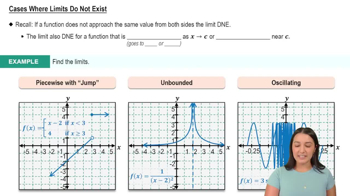Domains and Asymptotes
Determine the domain of each function in Exercises 69–72. Then use various limits to find the asymptotes.
y = (√(x² + 4)) / x
 Verified step by step guidance
Verified step by step guidance Verified video answer for a similar problem:
Verified video answer for a similar problem:



 6:47m
6:47mMaster Finding Limits Numerically and Graphically with a bite sized video explanation from Patrick
Start learning